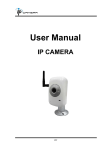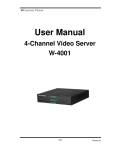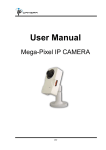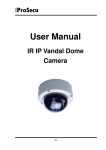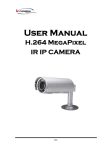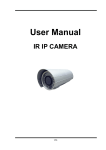Download User Manual 1/2/4 Ch Video Sever
Transcript
User Manual 1/2/4 Ch Video Sever V1.0 1/37 WARINGS TO REDUCE THE RISK OF FIRE OR ELECTRIC SHOCK, DO NOT EXPOSE THIS PRODUCT TO RAIN OR MOISTURE. DO NOT INSERT ANY METALLIC & ELETRIC CONDUCTIVE OBJECT THROUGH VENTILATION GRILLS. CAUTION CAUTION RISK OF ELECTRIC SHOCK DO NOT OPEN CAUTION:TO REDUCE THE RISK OF ELECTRIC SHOCK. DO NOT REMOVE COVER (OR BACK). NO USER-SERVICEABLE PARTS INSIDE. REFER SERVICING TO QUALIFIED SERVICE PERSONNEL. COPYRIGHT THE TRADEMARKS MENTIONED IN THE MANUAL ARE LEGALLY REGISTERED TO THEIR RESPECTIVE COMPANIES. 2/37 Content I. PREFACE .............................................................................................................................................. 4 II. PRODUCT SPECIFICATIONS ............................................................................................................ 4 III. PRODUCT INSTALLATION ............................................................................................................... 6 A. MONITOR SETTING .............................................................................................................................. 6 B. HARDWARE INSTALLATION ................................................................................................................... 7 C. IP ASSIGNMENT ..................................................................................................................................10 D. INSTALL ACTIVEX CONTROL (SETUP ONCE ONLY): ................................................................................13 IV. LIVE VIDEO ........................................................................................................................................15 V. VIDEO SERVER CONFIGURATION ................................................................................................17 A. SYSTEM .............................................................................................................................................18 B. NETWORK ..........................................................................................................................................21 C. A/V SETTING .....................................................................................................................................26 D. EVENT LIST ........................................................................................................................................32 VI. FACTORY DEFAULT ..........................................................................................................................37 VII. PACKAGE CONTENTS ......................................................................................................................37 3/37 I. PREFACE This is a four channel H.264/ MJPEG Video Server with web server built-in. It encodes analogue signals of traditional cameras to digital signals; the users can monitor real-time video via IE browser. H.264 and MJPEG compression format support smooth video quality. Also, it supports SD Card backup. 2-way audio enables the user to have a video conference. In addition, the user can control Video Server with user friendly interface via IE browser to build a home surveillance system. II. Product Specifications FEATURES: H.264/ MJPEG compression formats RS-485 Control Interface (PTZ) RS-232 Interface SD Card backup. Wireless network connection (802.11 b/ g) - Optional 2-way audio. 1/2/4 video input Free bundle software Wireless (Optional) 4/37 Hardware 1CH Server 2CH Server 4CH Server CPU ARM 9 ,32 bit RISC RAM 256MB ROM 16MB Video Input BNC x 1 BNC x 2 BNC x 4 Input Video Looping BNC x 1 -- BNC x 4 Audio In/Out (RCA) 1 in / 1 out 1 in / 1 out 4 in / 1 out Alarm Input 2 2 4 Relay Out 2 2 4 RS-485 X1, for PTZ control Power DC 12V, 630mA Dimensions (WxHxD) 133x107x42mm 133x107x42mm 218x202x44mm Network Ethernet 10/ 100 Base-T Network Protocol HTTP, TCP/ IP, UDP, SMTP, FTP, PPPoE, DHCP, DDNS, NTP Wireless(optional) Wireless Type 802.11b/g Security WEP,WPA-PSK,WPA2-PSK System Video Resolution NTSC: 720x480 , 704x480, 352x240, 176x144 PAL: 720x576 , 704x576, 352x288, 176x144 Video adjust Brightness, Contrast, Saturation, Hue Image snapshot Yes Full screen monitoring Yes Compression format H.264/MJPEG Video bitrate adjust CBR, VBR Motion Detection 3 Areas per channel Triggered action Mail, FTP, Save to SD storage, Relay Pre/Post alarm Yes Security Password protection Firmware upgrade HTTP mode, can be upgraded remotely Simultaneous connection Up to 8 Audio Yes, 2-way (Duplex Support) SD Card Management Recording trigger Motion Detection, IP check, Network break down 5/37 (wire only), Relay Video format AVI, JPEG Video Playback Yes Delete files Yes Browser requirement OS Windows 2000, XP, 2003, IE 6.0 or above Hardware Recommendation Intel Dual Core 1.66G,RAM: 1024MB, Graphic card: 128MB Minimum Intel 2.8G, RAM: 256MB, Graphic Card: 32MB III. Product Installation A. Monitor Setting i. Right-Click on the desktop. Select “ Properties”. ii. Change color quality to highest (32bit). 6/37 B. Hardware Installation i. Connect power adaptor ii. Connect Ethernet cable to Video Server iii. Connect Video Server to a computer or Local network. 7/37 B-1 I/O Control Instruction I/O terminal connector – used in application, for e.g., motion detection, event triggering, alarm notifications. It provides the interface to: 1 Digital Input (GND+Alarm) – An alarm input for connecting devices that can toggle between an open and closed circuit, for example: PIRs, door/window contacts, glass break detectors, etc. When a signal is received the state changes and the input becomes active. 1 Relay output (COM +N.O. / COM + N.C.) – An output to Relay switch, for example: LEDs, Sirens, etc Digital Input Alarm Input 1. GND (Ground) : Initial state is LOW 2. Alarm: Max. 50mA, DC 3.3V Relay Output 1. COM: (Common) 2. N.O. (Normally Open) / N.C. (Normally Close): Max. 1A, 24VDC or 0.5A, 125VAC GND ALARM ALARM IN (1~4) COM N.O./N.C. RELAY OUT (1~4) 8/37 B-2. Relay Connection: Digital Input connection Door/Window Contacts GND ALARM COM N.O./ N.C. Relay Output Connection GND ALARM COM N.O./ N.C. 9/37 C. i. ii. IP Assignment Use “IP Installer”, comes with CD, to assign the IP address of VIDEO SERVER. There are two languages for IP Installer: a. iii. iv. v. IPInstallerCht.exe: Chinese version b. IPInstallerEng.exe: English version 3 different IP configurations based on different environments. a. Fixed IP (Public IP or Virtual IP) b. DHCP (Dynamic IP) c. Dial-up (PPPoE) Execute IP Installer Use Windows XP SP2 or newer version. If the following message popup, please click “Unblock.” vi. The GUI of IP Installer: 10/37 vii. IP Installer searches all IP deceives which connect with the internet and it lists all of them on the left side or the user can click “Search Device” to search again. viii. When the user clicks on each IP device listed on the left side of IP Installer, the network configuration of the IP device will show on the right side. The user can change the parameter and click on “Submit”. And, then, the following message will popup. Click on “OK” to reboot VIDEO SERVER. ix. Please make sure the subnet of PC IP address and VIDEO SERVER IP address are the same. The same Subnet: VIDEO SERVER IP address: 192.168.1.210 PC IP address: 192.168.1.100 Different Subnets: VIDEO SERVER IP address: 192.168.2.210 PC IP address: 192.168.1.100 To Change PC IP address: Control PanelNetwork ConnectionsLocal Area Connection PropertiesInternet Protocol (TCP/IP) Properties Please make sure your Video Server and PC have the same Subnet. If not, please change Video Server subnet or PC IP subnet accordingly. 11/37 x. A quick way to access remote monitoring is to left-click the mouse twice on a selected Video Server listed on “Device list” of IP Installer. An IE browser will be opened. 12/37 xi. Then, please key in the default “user name: admin” and “password: admin”. xii. After VIDEO SERVER reboot, click “Search Device” to research VIDEO SERVER. And, use IE Browser for live viewing. D. Install ActiveX control (setup once only): For the first time to view VIDEO SERVER via IE browser, it will request the user to install ActiveX. Also, check the security setting as follows. i. IE Tools Internet Options… Security Tap Custom Level Security Settings Download unsigned ActiveX controls Select “Enable” or “Prompt (Recommend). ii. IE Tools Internet Options Security Tap Custom Level… Security Settings Initialize and script ActiveX controls not marked as safe Select “Enable” or “Prompt” (Recommend). 13/37 1 2 3 4 5 When popup the following dialogue box, click “Yes”. 14/37 IV. Live Video After executing IE browser and typing the IP address of VIDEO SERVER, the following message will popup and request the user to input the user name and password. The default user name and password are “admin” and “admin.” When the user name and the password are correct, it will connect to VIDEO SERVER via IE Browser. The GUI will display as follows. 4. 1. 5. 3. 6. 15/37 2. 1. :Get into the administration page. 2. :Video Snapshot. 3. Show how many users connect to this VIDEO SERVER. 4. 5. Shows system time, video resolution and video refreshing rate VIDEO SERVER supports 2-way audio. After click on “Chatting”, the user can use the microphone which connects with the PC to talk to the server side. Control the relay which is connected to this video server. Select PTZ protocol to control the PTZ camera which is connected the video 6. 7. server. The PTZ function will be slightly different depends on which protocol to use. Double-click on the video, it will change to full screen mode. Press “Esc” or double-click the video again, it will change back to normal mode. Right-Click the mouse on the video, it will show a pop-up menu. 1. Snapshot:Save a JPEG picture 2. Record Start:Record the video in the local PC. It will ask you where to save the video. To stop recording, right-click the mouse again. Select “Record Stop”. The video format is AVI. Use Microsoft Media Player to play the recorded file. 3. Mute: Turn of the audio. Click again to turn on it. 4. Full Screen: Display video in full-screen mode. 5. Zoom: Enable zoom-in and zoom-out functions. Select “Enable digital zoom” option first within the pop-up dialogue box and then drag and drop the bar to adjust the zoom factors. 16/37 V. VIDEO SERVER Configuration Click to get into the administration and click on viewing as follows. 17/37 to return to the live A. System i. System Setup Set up the video server name, select language, and the time on this video server. a. Sever name:This is the video server name for the user to search on b. IP Installer. Select language:There are English, Traditional Chinese, and simplified Chinese. When a certain language is selected, the following message will popup and ask the user to confirm language changed. c. Sever time setting:Select options to set up time - “NTP”, “Synchronize with PC’s time”, “Manual”, “The date and time remain the same”. ii. User Management Support three authorities: administrator (the highest), user, and anonymous user. Default Username and Password: admin/ admin 18/37 a. Anonymous User Login: Yes:Allow anonymous login. No:Require user name and password to login. b. Add user: Type the user name and password and then click on “Add/ Set”. c. iii. Click on “Edit” or “Delete” to modify the user. System update a. To update the firmware online, click “Browse…” to select the 19/37 b. c. d. firmware. Then click “Upgrade” to the proceed. Reboot system: re-start the Video Server Factory default: delete all the settings and restore defaults system. Setting Management:User may download the current setting to PC, or upgrade from previous saved setting. 1. Setting download: Right-click the mouse button on Setting Download Select 2. “Save AS…” to save current Video Server setting in PC Select saving directory Save Upgrade from previous setting Browse search previous setting open upgrade Setting update confirm click index.html to return to main page 20/37 B.Network i. IP Setting VIDEO SERVER supports static IP and DHCP. a. DHCP:Use Dynamic Host Configuration Protocol to get all network b. parameters automatically. Static IP:Type IP address, subnet mask, gateway, and DNS. c. DNS: d. With DHCP, DNS will be assigned automatically. Static IP: Based on the network environment. Port:If the user uses the router, some ports have to be adjusted in case of conflict. ii. PPPoE If the user wants to use ADSL, please select “Enabled”. Username: username for ADSL connection. Password: password for ADSL connection. Send mail after dialed:After this function is enabled, it will send an email iii. to a specific mail account. For the mail setting, please refer to IV. “Mail and FTP” settings. DDNS 21/37 VIDEO SERVER supports DDNS. It uses dynamic IP to redirect IP and connect with the video sever. VIDEO SERVER supports 3 kinds of DDNS severs, including dyndns.org, ddns.camddns.com, and ddns2.ydsdvr.com. a. DynDNS; 1. 2. DDNS Setting: Enable or Disable DDNS setting. Input the DynDNS’s host name, user name, and password. 3. Schedule Update: Default 1440 minutes. * dyndns.org: If the user’s schedule update is too often, it will be blocked. Recommend the user to update once per day (1440 minutes per day). Click on “Apply” to save. 4. 22/37 b. Camddns: 1. 2. 3. c. Input user name. Schedule Update: Default 1440 minutes. Click on “Apply” on save. DDNS State: 1. 2. Updating: Information updating. Idle: Stop Service. 3. DDNS registration successful, can now log by http://<username>.ddns.camddns.com: Register successfully. Update Failed, the name is already registered: The user name has already been used. Please change another one. Update Failed; please check your internet connection: Network 4. 5. connection failed. iv. Wireless Setting VIDEO SERVER supports 802.11b/g wireless connection. (Notice: While using wireless setting, the user has to unplug Ethernet cable because both use the same IP. If the user doesn’t unplug Ethernet cable, wireless setting can not be executed). 23/37 a. Status of Wireless Networks; b. it can scan all wireless services. Wireless Setting: 1. Mode:There are Infrastructure and Ad-hoc. Infrastructure is for connecting with the router. Ad-hoc is for connecting with PC. When the user uses Ad-hoc mode, “Channel” option can be selected. e.g. If one PC’s channel is 1, the other’s channel has to 1, too. 2. 3. SSID:Based on AP setting. Channel:This is only be used when the user selects Ad-hoc 4. mode in order to avoid conflict. Security:It supports “None”, “WEP”, “WPA-PSK” security encryption based on the setting of the Router. 『WEP』 Authentication:There are Open System and Shared Keys, it is based on different encryptions. This has to be the same as the Router’s setting. Encryption:There are 64 bits and 128 bits. This is based on Key Type based on the Router’s setting. Key Type:There are HEX and ASCII. When selecting HEX, 24/37 the user only can input 0~9 characters and use A, B, C, D, E, and F. And, when selecting ASCII, the user can input any character. (case [upper cases/ lower cases] sensitive). Key 1~4:Based on Key Type to input characters. 『WPA-PSK』: Encryption:There are TKIP and AES. Pre-Shared Key:Allow any characters (case [upper cases/ lower cases] sensitive). 25/37 C. A/V Setting i. Image Setting For security purpose, there are three areas can be setup for privacy mask. Click area button first to pull a area on the above image. Finally click “Save” button to reserve the setting. Adjust “Brightness”, “Contrast”, “Hue” and “Saturation” to get clear video. 26/37 ii. Video Setting a. Streaming 1 Basic Mode: 1. Resolution: There are 4 resolutions to choose. NTSC / PAL D1 – 720×480 / 720×576 4CIF – 704×480 / 704×576 CIF – 352×240 / 352×288 QCIF – 176×120 2. Quality: / 176×144 There are 5 levels to adjust: Best/ High/ Standard/ Medium/ Low The higher the quality is, the bigger the file size is. Also not good for internet transmitting 3. Video Frame Rate: The video refreshing rate per second. 4. Video Format: H.264 or MJPEG. 5. RTSP Path: RTSP output name 27/37 b. Streaming 1 Advanced Mode: 1. Resolution: There are 4 resolutions to choose. NTSC / PAL D1 – 720×480 / 720×576 4CIF – CIF – QCIF – 704×480 352×240 176×120 / / / 704×576 352×288 176×144 2. Bitrate Control Mode There are CBR (Constant Bit Rate) and VBR (Variable Bit Rate) to use. CBR:32Kbps~4Mbps – Increase CBR to increase the picture quality; vise versa VBR:1(Low)~10(High) – Compression rate, the higher the compression rate, the lower the picture quality is; vise versa. The balance between VBR and network bandwidth will affect picture quality. Please carefully select the VBR rate to avoid picture breaking up or lagging. 3. Video Frame Rate Picture display frame per second NTSC: Max 30 frames/second PAL: Max 25 frames/second 4. GOP Size It means "Group of Pictures". The higher the GOP is, the better the quality is. 5. Video Format: There are 2 Video Format to choose H.264 or MJPEG. 28/37 6. RTSP Path: RTSP output connecting route c. Streaming 2 Basic Mode: 1. Resolution: There are 4 resolutions to choose. NTSC / PAL D1 – 720×480 / 720×576 4CIF – 704×480 / 704×576 CIF – 352×240 / 352×288 QCIF – 176×120 / 176×144 2. Quality: There are 5 levels to adjust: Best/ High/ Standard/ Medium/ Low The higher the quality is, the bigger the file size is. Also not good for internet transmitting 3. Video Format:H.264 or JPEG 4. RTSP Path: RTSP output connecting route 29/37 d. Streaming 2 Advanced Mode: 1. Resolution: There are 4 resolutions to choose. NTSC / PAL D1 – 720×480 / 720×576 4CIF – CIF – QCIF – 704×480 352×240 176×120 / / / 704×576 352×288 176×144 2. Bitrate Control Mode There are CBR (Constant Bit Rate) and VBR (Variable Bit Rate) to use. CBR:32Kbps~4Mbps (the higher the CBR is, the better the video quality is) VBR:1~10 (Compression Rate) 3. Video Frame Rate: The video refreshing rate per second. 4. GOP Size It means "Group of Pictures". The higher the GOP is, the better the quality is. 5. Video Format:H.264 or JPEG 6. RTSP Path: RTSP output name 30/37 e. 3GPP Streaming Setting mode: 3GPP default value is Resolution=176x144, 5FPS,Format=MPEG4 1. Enable or Disable 3GPP Streaming 2. 3GPP: 3GPP output name iii、 Audio: Video Server supports 2-way audio. a. From video server to local PC, select “Enable” to start this function (When enabled, you can send audio via external mic in the IP Camera) b. From local PC to Video Server, check “chatting” in the browsing page (You will need a mic to send audio from local PC to IP Camera) Note: The Audio will not be smooth when enable SD card recording function simultaneously. 31/37 D. Event List VIDEO SERVER provides multiple event settings. i. Event Setting a. Motion Detection: Video Server allows 3 areas motion detection. When motion is triggered, it can send the video to some specific mail addresses, transmit the video to remote ftp server, trigger the relay, and save video to local SD card. To set up the motion area, click “Area Setting”. Using mouse to drag and draw the area. The same operation for area 2 and 3. b. Record File Setting: IP CAMERA allows 3 different types of recording file to change its record size. When motion/alarm is triggered, there are 3 different types of record mode. 1. AVI File (With Record File Setting) 2. Multi-JPEG (With Record File Setting), only with JPEG compression format. 3. Single JPEG (Single File with Interval Setting) 32/37 c. Record Time Setting: Pre Alarm and Post Alarm setups for video start and end time when motion detected, I/O, or other devices got triggered. Note: Pre/Post Alarm record time is base on record time setting and IP Cam built-in Ram memory. Limited by IP Cam built-in Ram Memory, When information is too much or video quality set too high, it will cause recording frame drop or decrease on post alarm recording time. d. Network Dis-connected When the network is down, it will save the video to local SD card. This function is only enabled in wire connection. e. Network IP check When the connection is down, it records the video to SD card. Make sure the video recording is continuous. To use this function, key in the IP address of the PC which has recording software installed. Enable the function of “Save to SD card”, then click “Apply”. The interval of two video files on SD card is fixed with 30 seconds. ii. Schedule a. Schedule: After complete the schedule setup, the camera data will be recorded according to the schedule setup. b. Snapshot: After enable the snapshot function, user can select the storage position of snapshot file, the interval time of snapshot and the reserved file name of snapshot. 33/37 iii. I/O Setting Video Server supports 2 input/ 2 Relay output. When input is triggered, it can send the video to some specific mail addresses, transmit the video to remote ftp server, trigger the relay, and save video to local SD card. iv. Mail & FTP To send out the video via mail of ftp, please set up the configuration first. 34/37 To send out the video via mail or FTP, please set up the configuration first. v. Log List Sort by System Logs, Motion Detection Logs and I/O Logs. In addition, System Logs and I/O Logs won’t lose data due to power failure. vi. SD card Please Insert SD card before use it. Make sure pushing SD card into the slot completely. Note:The use of the SD card will affect the operation of the Video Server slightly, such as affecting the frame rate of the video. a. Playback: 1. It will show the capacity of the SD card. Click the date listed on this page. It will show the list of the video. 35/37 2. The video format is AVI. Click the video to start Microsoft Media 3. Player to play it. To delete the video, check it, then click Del. When the SD card is full, it will remove the oldest video automatically. vii. Log List Sort by System Logs, Motion Detection Logs and I/O Logs. In addition, System Logs and I/O Logs won’t lose data due to power failure. 36/37 VI. Factory Default To recover the default IP address and password, please follow the following steps. 1. Remove power and press and hold the button in the back of Video Server. 2. Power on the Video Server. Don’t release the button during the system booting. It will take around 30 seconds to boot the Video Server Release the button when Video Server finishes proceed Re-login the Video Server using the default IP (http://192.168.1.210), and 3. 4. 5. user name (admin), password (admin). VII. Package contents 1. 2. Video Server Adaptor 3. 4. Ethernet Cable CD (user manual, IP installation utility). 37/37






































